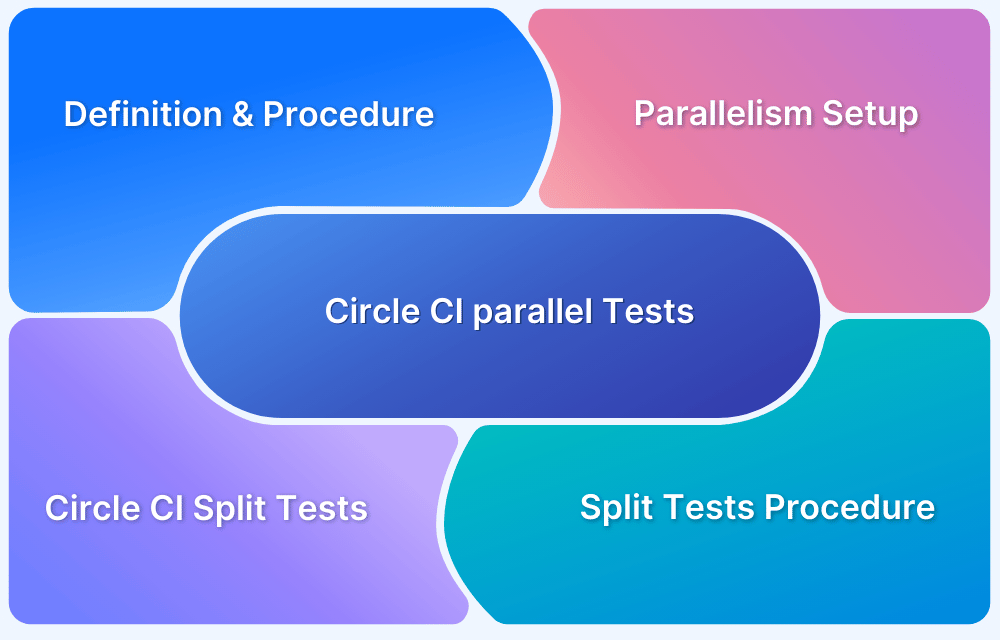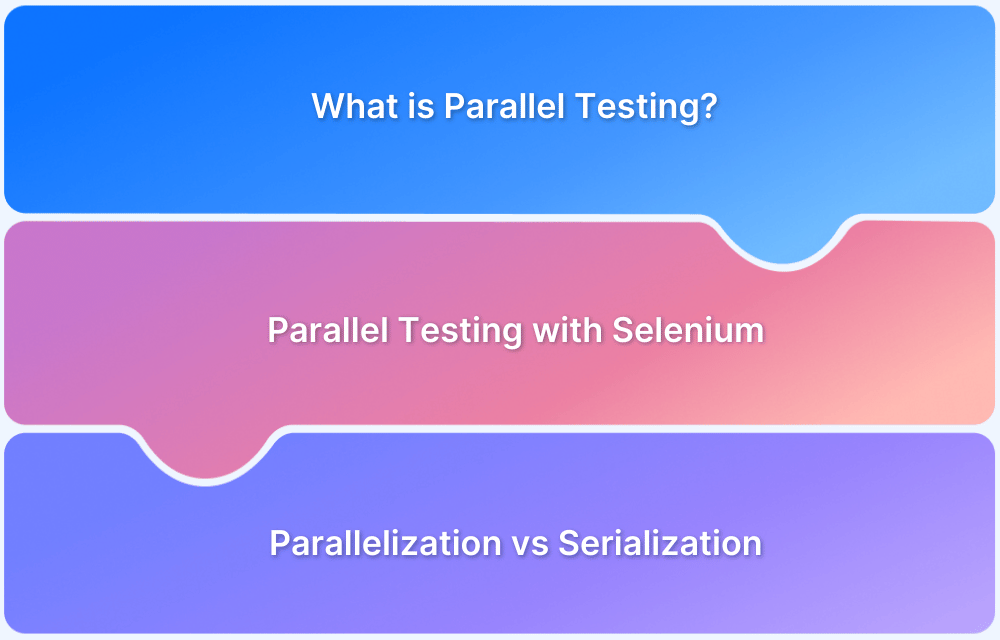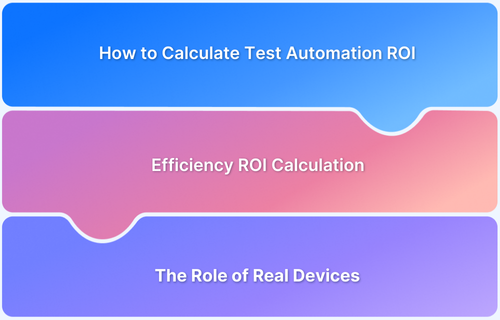Efficient CI/CD pipelines are essential for maintaining rapid software delivery and ensuring consistent quality. As applications become more complex, pipeline execution time can increase, slowing development cycles. Parallel testing is one of the most effective methods to accelerate testing and deliver faster feedback.
Overview
Parallel testing in CI/CD involves executing multiple tests simultaneously rather than sequentially. This approach maximizes resource usage and shortens the overall testing phase within the pipeline.
How Parallel Testing Speeds Up CI/CD:
- Reduces total test execution time by running tests concurrently
- Enables faster feedback to developers, improving productivity
- Increases test coverage without extending pipeline duration
- Optimizes infrastructure utilization across multiple environments
- Helps identify issues earlier by distributing tests efficiently
Other Methods to Speed Up CI/CD:
- Building only what’s changed (incremental builds)
- Limiting the size and scope of feature changes per commit
- Caching dependencies and build artifacts for reuse
- Implementing canary releases for safer, faster deployments
- Using containerization to isolate and speed up builds and tests
- Continuously analyzing and optimizing your pipeline performance
This article explores the benefits of parallel testing in CI/CD, key tools and frameworks, and additional strategies to speed up pipelines.
Why Optimize CI/CD Pipeline?
As applications scale and development accelerates, optimizing the CI/CD pipeline becomes essential for the following reasons:
- Increased complexity and volume of code changes can slow down build and test processes.
- Delays in the pipeline reduce developer productivity and slow release cycles.
- Slow pipelines hinder quick response to market demands and customer feedback.
- Optimized pipelines enable faster integration and early defect detection.
- Faster, more reliable deployments improve overall software quality.
- Streamlined CI/CD supports continuous delivery and accelerates time to market.
Understanding Parallel Testing in CI/CD
In a typical CI/CD setup, running tests sequentially can become a bottleneck, especially as the number of test cases grows. Each test must wait for the previous one to finish, which can lead to long wait times, delayed feedback for developers, and slower overall release cycles.
This approach is not scalable for modern development workflows where speed and frequent deployments are critical.
Parallel testing addresses this challenge by allowing multiple tests to run simultaneously across different environments or machines. Instead of queuing tests one after another, the CI/CD system distributes and executes them in parallel, significantly reducing total execution time and accelerating the feedback loop.
When automated within the CI/CD pipeline, parallel testing becomes even more powerful. Automated test execution ensures consistency across builds and removes manual intervention, allowing every code change to be validated quickly and reliably. This enables teams to detect issues early, maintain high test coverage, and deliver quality software at speed.
Platforms like BrowserStack make this process even more seamless by offering a scalable Cloud Selenium Grid to run tests in parallel across a wide range of real browser and device combinations, helping teams accelerate testing without the need to maintain complex in-house infrastructure.
Benefits of Parallel Testing in CI/CD
Parallel testing helps accelerate software delivery while maintaining test coverage and reliability. Key benefits include:
- Reduced Test Execution Time: Tests run simultaneously, cutting down overall execution time and enabling faster feedback.
- Efficient Resource Utilization: Maximizes hardware usage and reduces infrastructure costs by avoiding idle compute time.
- Broader Test Coverage: More tests can be executed within the same time window, improving application coverage.
- Faster Pipeline Execution: Speeds up the CI/CD cycle by reducing the time spent on testing stages.
- Early Bug Detection: Issues are identified faster across different modules or configurations.
- Scalability: Easily handles growing test suites by distributing load across available infrastructure.
Read More: Best 20 Test Automation Frameworks in 2025
Parallel Testing Tools and Platforms
To implement parallel testing effectively, teams rely on a range of tools and frameworks that enable simultaneous execution across different environments, devices, and browsers. Here are some popular tools:
- BrowserStack: A cloud-based testing platform that offers parallel test execution on a vast range of real browsers and devices through its scalable Selenium Grid and real device cloud. It simplifies infrastructure management and accelerates cross-browser and cross-device testing.
- Cypress: Supports parallel end-to-end testing for modern web applications.
- Playwright: Enables cross-browser parallel testing with multi-language support.
- Puppeteer: A Node.js library for Chrome/Chromium automation, supporting parallel runs via test frameworks.
- Appium: Facilitates parallel testing of mobile apps across multiple devices and platforms.
- Nightwatch.js: A Node.js-based tool supporting parallel end-to-end testing for web apps.
- Selenium WebDriver: The widely used open-source browser automation tool, often combined with frameworks like TestNG or JUnit for parallel test execution.
CI/CD Platforms Integration:
Most CI/CD tools, such as Jenkins, GitLab CI, and GitHub Action, natively support parallel testing, allowing efficient orchestration of distributed tests.
By combining these tools with scalable infrastructure like BrowserStack Automate, teams can accelerate test cycles, broaden coverage, and deliver quality software faster.
Leverage Parallel Testing Infrastructure
Efficient use of testing infrastructure is critical to maximizing the benefits of parallel testing. Many organizations face challenges in balancing infrastructure costs and utilization.
Under-provisioning can create bottlenecks that slow test execution, while over-provisioning leads to wasted resources and increased expenses.
To overcome these challenges, collaboration between DevOps and QA teams is essential. Understanding the frequency, scale, and complexity of test suites helps in planning the right infrastructure capacity and scheduling tests to optimize resource use.
Key strategies to leverage parallel testing infrastructure effectively include:
- Dynamic Resource Allocation: Use cloud-based or containerized environments that can scale up or down based on testing demand, avoiding idle infrastructure costs.
- Test Scheduling: Prioritize and schedule tests strategically to run concurrently without overloading the system, ensuring continuous hardware utilization.
- Infrastructure as Code (IaC): Automate infrastructure provisioning and teardown to spin up environments on-demand for parallel test runs, improving efficiency and reducing manual overhead.
- Load Balancing: Distribute test workloads evenly across available machines or devices to prevent any single resource from becoming a bottleneck.
By adopting these approaches, teams can accelerate test execution, reduce infrastructure costs, and maintain high test coverage, driving faster and more reliable CI/CD pipelines.
Read More: Parallel Testing with Selenium
Check Impact with Parallel Test Calculator
Parallel Execution of Tests and Test Suites
Parallel execution can be applied both at the individual test case level and the broader test suite level, each offering distinct benefits for accelerating CI/CD pipelines.
Parallel Execution of Test Cases
It involves running multiple independent test cases simultaneously. Since these tests do not depend on each other, executing them in parallel maximizes infrastructure usage and significantly reduces overall test execution time.
This approach is particularly effective for large test suites where many tests can run concurrently without conflicts.
Parallel Execution of Test Suites
It takes parallelization a step further by running entire groups of tests on isolated environments. This is especially useful for long-running tests or scenarios requiring validation across multiple application versions.
Utilizing containerization technologies like Docker, temporary and independent test environments can be spun up on demand, allowing multiple test suites to run concurrently without interference. After completion, these containerized environments are destroyed, optimizing resource utilization.
By implementing parallel execution at both test case and test suite levels, teams can drastically reduce feedback cycles, increase test coverage, and speed up software delivery.
Read More: How to run Parallel Tests with CircleCI
Best Practices for Effective Parallel Testing in CI/CD Pipelines
Implementing parallel testing effectively requires thoughtful planning and adherence to best practices to maximize speed, reliability, and test coverage:
- Identify Independent Tests: Ensure tests are designed to be independent and stateless so they can run concurrently without interfering with each other.
- Prioritize Test Selection: Not all tests need to run in parallel. Prioritize critical, long-running, or high-impact tests to optimize resource use and accelerate feedback where it matters most.
- Balance Test Load Across Environments: Distribute tests evenly across available infrastructure to avoid bottlenecks. Monitor resource utilization and scale environments dynamically to handle peak loads.
- Use Reliable Test Data Management: Maintain clean and consistent test data environments to prevent conflicts during parallel execution. Isolate data sets or use containerized test environments to ensure stability.
- Integrate with CI/CD Pipelines Seamlessly: Automate parallel test execution within your CI/CD workflow for smooth, hands-off operation. Use pipeline tools that support parallel jobs and enable easy reporting and monitoring of results.
- Monitor and Analyze Results Continuously: Track test execution metrics and failures in real-time. Use this data to identify flaky tests, infrastructure issues, or test design flaws that may hinder parallel execution efficiency.
- Leverage Scalable Cloud Infrastructure: Scaling your testing infrastructure on-demand helps accommodate varying test loads without overprovisioning or delays.
Other Methods to Speed Up CI/CD Pipeline
Beyond parallel testing, several additional practices can significantly enhance the speed and efficiency of CI/CD pipelines:
Build Incrementally
Instead of rebuilding the entire application after every change, incremental builds compile only the modified components. This reduces build time and accelerates the feedback loop for developers.
Limit Changes
Avoid bundling too many feature changes or code updates in a single commit or build. Smaller, focused changes enable quicker builds and tests, reduce the risk of conflicts, and simplify troubleshooting.
Cache Dependencies and Artifacts for Faster Reuse
Caching frequently used dependencies, libraries, and build artifacts prevents redundant downloads and rebuilds. Effective caching minimizes setup time and resource consumption during pipeline runs.
Implement Canary Releases
Gradually rolling out new features to a subset of users through canary releases helps detect issues early without affecting the entire user base. This approach allows faster, safer deployments and quicker rollbacks if needed.
Utilize Containerization
Using containers standardizes build and test environments, ensuring consistency across stages. Containers enable faster provisioning of isolated environments, simplify dependency management, and support scalable parallel testing.
Analyze Your Pipeline
Regularly monitor and analyze pipeline performance to identify bottlenecks and inefficiencies. Using metrics and logs helps teams optimize processes, eliminate delays, and continuously improve pipeline speed and reliability.
Conclusion
Optimizing CI/CD pipelines is critical for accelerating software delivery and maintaining high quality. Parallel testing stands out as a powerful method to reduce test execution time, improve resource utilization, and expand test coverage.
When combined with other strategies like incremental builds, caching, and containerization, it can significantly enhance pipeline efficiency.
Implementing parallel testing effectively requires careful planning, robust infrastructure, and close collaboration between development, QA, and DevOps teams.
Leveraging cloud-based solutions such as BrowserStack can simplify infrastructure management and scale testing across numerous browser and device combinations, ensuring faster feedback and more reliable releases.
BrowserStack automates infrastructure management, supports seamless CI/CD integration, and accelerates testing speed, empowering teams to deliver quality software faster and more reliably.
By adopting these best practices and complementary methods, organizations can streamline their CI/CD workflows, deliver features more rapidly, and maintain the stability and quality their users expect.
Useful Resources for CI/CD
Understanding CI/CD
- What is CI/CD? (Differences, Benefits, Tools, Fundamentals)
- CI vs CD: Difference between Continuous Integration and Continuous Delivery?
- How to implement a CI/CD Pipeline?
- How to build an effective CI CD pipeline
- 15 CI/CD Challenges and its Solutions
- Continuous Delivery vs Continuous Deployment: Core Differences
- What is Continuous Testing in DevOps
- Continuous Testing Strategy in DevOps
- Continuous Integration in Agile
- Jenkins Continuous Integration Tutorial
- Difference between CI and CD, Agile and DevOps
- Devops CI: Continuous Integration in DevOps
- How to Build an Azure CI/CD Pipeline?
Tools and Comparisons
- Top 18 Continuous Integration Tools in 2024
- Top 15 CI CD Tools for your DevOps project in 2024
- Difference between Jenkins vs Gitlab CI
- Jenkins vs Travis: The War of CI Tools
- CircleCI vs Travis CI: Core Differences
- How CI CD Tools have revolutionised Automation Testing?
Best Practices, Tips, and Tricks
- How to optimize test cases for Continuous Integration
- How to run test on GitLab CI Locally
- Role of Automation Testing in CI/CD
- Is CI/CD Integration with Mobile App Testing possible?
- Moving from CI to CD using Automated Visual Regression Testing
- Accelerate CI/CD pipelines with Parallel Testing
- CI/CD Strategies for Faster Application Releases







